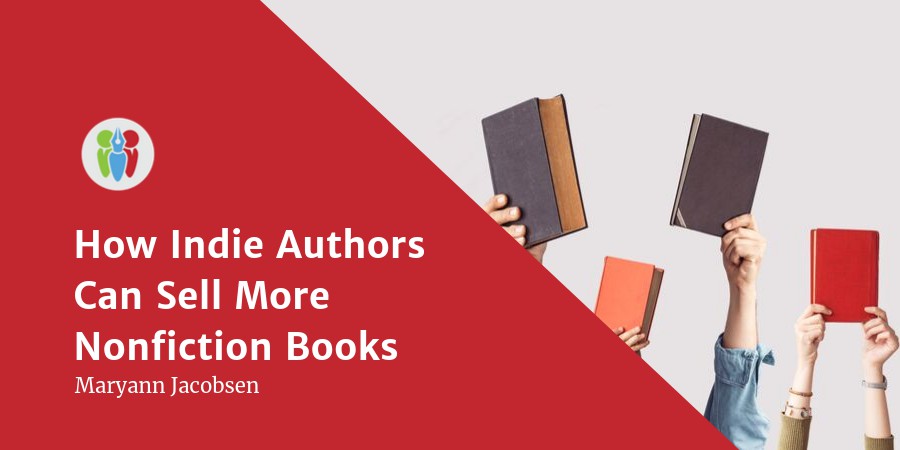Paid ads and marketing isn't for everyone. But in a pay to play market, what else is there? Maryann Jacobsen, ALLi author member, looks to content marketing to sell more nonfiction books. While nonfiction book marketing strategies may come and go but there is one strategy that still works: writing killer blog posts.
As a registered dietitian turned indie author, I’m always brainstorming new and exciting posts I can write to boost my book sales. I’ve seen firsthand that the right blog post can make a big difference in terms of sales and attention.
How Indie Authors Can Sell More Nonfiction Books

Maryann Jacobsen
Blog posts are also a good way to educate potential readers about why your book is needed. After writing six books and numerous blog posts, I’ve come to appreciate five that work well for nonfiction. These posts can be written before, during, and after a book is published.
Let’s take a look.
Book-related Series
I struggle with finding time to write my books and keep my blog updated. One solution is to blog about the book I’m writing. This gives readers a preview of the book’s content while creating interest. I often run a book-related blog series that ends with the publication of the book. When the book is published, at the end of each post I include a blurb about the book, a link to Amazon, and a picture of the cover. Then I share the series with new newsletter sign-ups and on my Blog Topics page.
Don’t forget to include links of the entire series, in order, at the end of each post for easy navigation (see an example here). I have a series for each of my books, which I periodically run on social media long after the book is published. This helps the book sell over the long haul, not just at launch.
Op-Ed Piece
My personal favorite is the Op-Ed post which includes a stated opinion/argument followed by evidence to back it up. Great Op-Ed pieces include personal stories, credibility, must-read titles, and an element of counter intuitiveness. This is the place to include the research you worked so hard to create for your nonfiction book. I believe the most compelling argument is your book’s hook: the reason you wrote the book in the first place.
I recently wrote an Op-Ed piece for my latest book My Body’s Superpower: the Girls’ Guide to Growing Up Healthy During Puberty. I wrote this book to teach girls what to expect during puberty including weight gain. Unfortunately, too many girls (and parents) think something’s wrong when they gain body fat, which leads to a poor body image and unhealthy habits. So the title for this piece got straight to the point: Your Daughter Doesn’t Have a Weight Problem. She’s Going Through Puberty. I published it on Linkedin Pulse and it had a significant impact on my book sales and me to #1 in an Amazon category.
Back when the NY Times called their parenting blog Motherlode, I wrote a piece entitled Saying Good Riddance to Clean Your Plate Club. In it, I detail why we need to stop asking kids to clean their plates with supportive research. This post did so well, that Good Morning America interviewed me and filmed my family eating a meal together! The Daily Mail even covered it. And the sales for my book Fearless Feeding skyrocketed.
If you want to find out submission guidelines for your Op-Ed piece check out The Op-Ed Project which lists out all the places you can submit. They also provide tips on how to write an Op-Ed.
List post
When Amy Morin wrote the post 13 Things Mentally Strong People Don’t Do, it got her a book deal with the same name. That’s the power of a list post. When you have compelling content that people want to read, it ups the odds it will go viral. When people see the headlines, they will want to know what the 5, 6, 7 or 10 things are.
As you’re writing your book, consider the different problems you are solving and turn it into a list format. I decided to write a mega-list post about girls and body image and inspired by Morin’s post I came up with 13 Things Girls with a Healthy Body Image Don’t Do. This post did well and I’ve used it as a source of information as I’ve contacted other health professionals and bloggers about the book.
For more tips check out Copyblogger’s The 7 Keys to List Posts That Are Worth Writing (and Reading)
Guest post
When I contact bloggers about my book, I always offer to write a guest post. I do this because it brings in new readers and I can write a list post, op-ed piece, or any how-to related to my book. I spend extra time on these posts because I want them to do well.
When writing for someone else, consider the blogs’ content and posts that have done well on the site. Most bloggers love guest posts because it frees them up to other stuff and it brings their blog traffic. But it has to be good!
Feel free to email a variety of blogs – even the big ones – that are in your book’s genre. Make the pitches short but impactful stating who you are, how your post can help them (and their readers), and bit about your book. Spring is a good time because many bloggers take time the summer months off.
Keyword post
Although all blog posts should include keywords, it’s worth it to search for keywords related to your book. In doing this, you can find gaps that a post can potentially fill. If a post does well enough and gets backlinks, it can start showing up in Google searches. Then at the end of the post you can have your book available.
But no one (not even Google) likes boring SEO posts. Simply use the words people are searching for as inspiration for posts. Then hopefully people will run across your post and see your book has the answer to their problem.
How to Include Your Book
It goes without saying that you want a link to your book to be somewhere either in the post or at the end of the post in your bio. On the one hand, you don’t want to be too salesy by including your book everywhere in the post. But you also want to be sure the reader knows your book is available and provides more in-depth coverage of the topic.
Sometimes the answer is already made for you. For example, most online publications will only accept a book mention in the bio. But you can be more forthcoming on your own blog or in guest posts. I’ve done both and feel you just have to decide what’s best based on the circumstances.
A call to action at the end of posts is a good idea, mentioning how your book is the answer. Of course, all this means you need to clearly define your audience and the problem your book solves.
So that’s it. Five posts that can help boost your nonfiction sales. Which one of these posts (or another one) has helped you sell more books?
Maryann Jacobsen, MS, RD, runs The Healthy Family Podcast and blogs at MaryannJacobsen.com. Connect with her on Facebook, Twitteror Instagram.
How Indie Authors Can Sell Nonfiction Books @mtjacobsen #indieauthor #selfpublishing #IARTG #ASMRG #writingcommunity Share on X
OVER TO YOU
Have you written blog posts for either your fiction or nonfiction books? Has it helped sell more nonfiction books or promotion?




